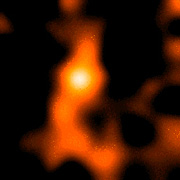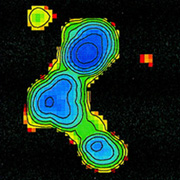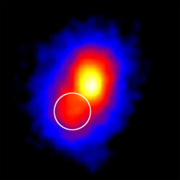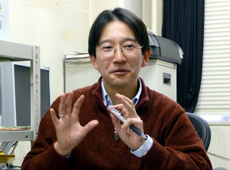Q. What is the most impressive result from Japanese X-ray astronomy satellites to date?

X-ray image of the “dark galaxy cluster” AX J2019+1127, captured by the X-ray satellite ROSAT. In this area, Japan’s X-ray astronomy satellite ASCA discovered high-temperature gas at approximately 100 million degrees Kelvin. The brighter sections indicate stronger X-ray emissions. (courtesy: Hattori et al. (1997) Nature 388, 146)

AX J2019+1127 observed by the Chandra X-ray Observatory. These lights turned out to be not a galaxy cluster but several small celestial objects twinkling individually. (courtesy: Chartas et al. (2001) The Astrophysical Journal 550, L163)
I started working in this field when I was a graduate student in the mid- 1990s, which happened to overlap with the period when a Japanese X-ray astronomy satellite, ASCA, was active. So I got ASCA’s results in real time, and these results really stand out in my memory.
ASCA had many achievements, so it is hard for me to pick just one, but specifically its report on the discovery of a “dark galaxy cluster” left a large impression on me. At the time, there was a mysterious area where the gravitational lensing effect was detected but no celestial object causing it could be seen. Through ASCA’s X-ray observations, hot gas with a temperature of about 100 million degrees Kelvin was detected and recognized as a galaxy cluster. If this was a real galaxy cluster, it would be among the most distant ones ever discovered with X-rays. It was bright only in X-rays and appeared to lack galaxies that normally would be observed in optical wavelengths. This object became a hot topic and was called a “dark galaxy cluster.”
Unfortunately, after a few years, this interpretation turned out to be incorrect. When Chandra X-ray Observatory imaged the same area, it turned out this wasn’t a galaxy cluster but just a group of several small celestial objects that were shining individually.
Despite this unfortunate result, the method – studying distant objects through a combination of the gravitational lensing effect and X-ray observations – was very refreshing, and has been applied widely ever since. We have learned various deep lessons through a series of events related to the dark galaxy cluster, such as the importance of developing new methods and the need to make the most of the strengths of instruments while fixing their weaknesses at the same time.




